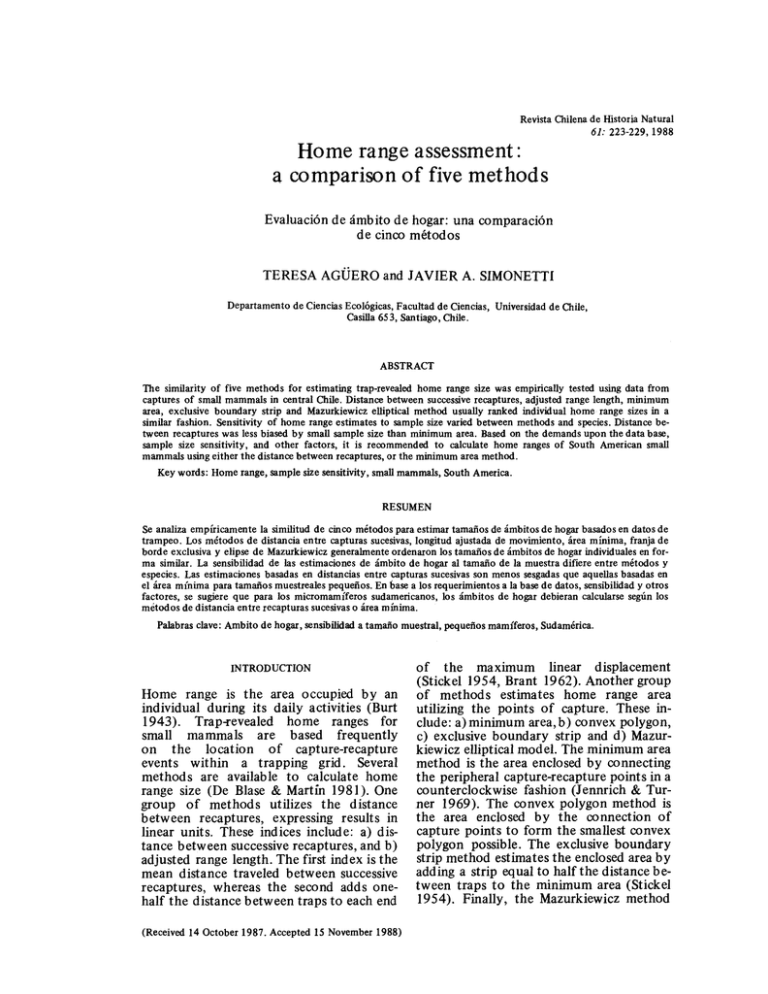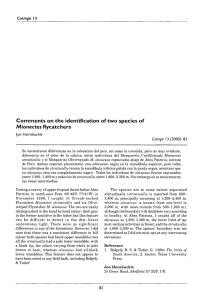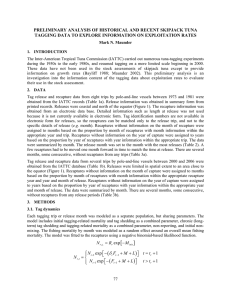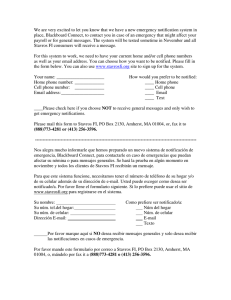Home range assessment - Revista Chilena de Historia Natural
Anuncio

Revista Chilena de Historia Natural
61: 223-229, 1988
Home range assessment:
a comparison of five methods
Evaluaci6n de ambito de hogar: una comparaci6n
de cinco metodos
TERESA AGhERO and JAVIER A. SIMONETTI
Departamento de Ciencias Ecologicas, Facultad de Ciencias, Universidad de Chile,
Casilla 653, Santiago, Chile.
ABSTRACT
The similarity of five methods for estimating trap-revealed home range size was empirically tested using data from
captures of small mammals in central Chile. Distance between successive recaptures, adjusted range length, minimum
area, exclusive boundary strip and Mazurkiewicz elliptical method usually ranked individual home range sizes in a
similar fashion. Sensitivity of home range estimates to sample size varied between methods and species. Distance between recaptures was less biased by small sample size than minimum area. Based on the demands upon the data base,
sample size sensitivity, and other factors, it is recommended to calculate home ranges of South American small
mammals using either the distance between recaptures, or the minimum area method.
Key words: Home range, sample size sensitivity, small mammals, South America.
RESUMEN
Se analiza empiricamente Ia similitud de cinco mptodos para estimar tamafios de ambitos de hogar basados en datos de
trampeo. Los metodos de distancia entre capturas sucesivas, longitud ajustada de movimiento, irea minima, franja de
borde exclusiva y elipse de Mazurkiewicz generalmente ordenaron los tamafios de ambitos de hogar individuales en forma similar. La sensibilidad de las estimaciones de ambito de hogar a! tamaxo de Ia muestra difiere entre metodos y
especies. Las estimaciones basadas en distancias entre capturas sucesivas son menos sesgadas que aquellas basadas en
el irea minima para tamafios muestreales pequeiios. En base a los requerimientos a Ia base de datos, sensibilidad y otros
factores, se sugiere que para los micromamiferos sudamericanos, los ambitos de hogar debieran calcularse seg~n los
metodos de distancia entre recapturas sucesivas R irea minima.
Palabras clave: Ambito de hogar, senstbilidad a tamaxo muestral, pequeiios mam{feros, Sudamprica.
INTRODUCTION
Home range is the area occupied by an
individual during its daily activities (Burt
1943). Trap-UHvealed home ranges for
small mammals are based frequently
on the location of capture-recapture
events within a trapping grid. Several
methods are available to calculate home
range size (De Blase & Martin 1981). One
group of methods utilizes the distance
between recaptures, expressing results in
linear units. These indices include: a) distance between successive recaptures, and b)
adjusted range length. The first index is the
mean distance traveled between successive
recaptures, whereas the second adds onehalf the distance between traps to each end
(Received 14 October 1987. Accepted 15 November 1988)
of the maximum linear displacement
(Stickel 1954, Brant 1962). Another group
of methods estimates home range area
utilizing the points of capture. These include: a) minimum area, b) convex polygon,
c) exclusive boundary strip and d) Mazurkiewicz elliptical model. The minimum area
method is the area enclosed by connecting
the peripheral capture-recapture points in a
counterclockwise fashion (J ennrich & Turner 1969). The convex polygon method is
the area enclosed by the connection of
capture points to form the smallest convex
polygon possible. The exclusive boundary
strip method estimates the enclosed area by
adding a strip equal to half the distance between traps to the minimum area (Stickel
1954). Finally, the Mazurkiewicz method
224
AGhERO & SIMONETTI
calculates home range size by estimating
the area of an ellipse determined by the
covariance of the capture points (Mazurkiewicz 1971 ; see also J ennrich & Turner
1969).
A growing number of studies are including estimates of home range sizes for South
American small mammals. The distance
between successive recaptures has been
used by Greer (1965), Contreras (1973),
Dalby (1975), Pearson & Ralph (1978),
Pearson (1983), Simonetti (1986), Murua
et al. (1987), and Nitikman & Mares (1987),
and the adjusted range length by Fulk
(1975). The minimun area method has
been used by Alho & Souza ( 1982) and
R.A. Ojeda (1986, personal communication), the exclusive boundary strip by
Contreras (1972), the inclusive boundary
strip by Ernest & Mares ( 1986), and Mazurkiewicz's method by Gonzalez et al.
( 1982) and MuU~a et al. ( 1986). In some
cases, different methods have been used
for the same species: e.g. the boundary
strip, distance between recaptures, and
Mazurkiewicz ellipse have all been used
to estimate home range size of Oryzomys
longicaudatus (Bennett 1832), and the
adjusted range length, distance between
recaptures, and Mazurkiewicz ellipse methods have all been used for Akodon olivaceus
(Waterhouse 1837) (Contreras 1972, Fulk
197 5, Gonzalez et al. 19 8 2, Mur~a et al.
1986, 1987).
The use of different methods for a single
species renders comparisons, and eventual
generalizations, difficult to interpret. Differences in home range size could be either
a real biological difference or an artifact of
the methodology used in the calculations.
Our goal is to compare the results of five
methods commonly used for home range
assessment using the same set of data. If
two or more methods yield comparable
results, the ranking of individuals and
species according to home range size should
be positively correlated. Support of this
hypothesis would allow one to compare,
qualitatively at least, populations studied
by different methods.
At the same time, we tested the sensitivity to sample size of the simplest home
range methods. Home range calculations
are strongly dependent on the number of
recapture events with the accuracy of the
estimates increasing asymptotically with
sample size (Mares et al. 1980, Swihart &
Slade 1985). In general, no clear procedure
has been followed by researchers of South
American mammals in this regard. Criteria
for inclusion of data in the analysis range
from just one up to at least seven recaptures
(e.g., Ernest & Mares 1986, Nitikman &
Mares 1987). Therefore, even when using
the same method, comparison between
populations or species may be obscured by
the undetected effect of sample size.
MATERIAL AND METHODS
Empirical testing of the similarity and
sensitivity of home range methods was
effected on small mammal populations
in central Chile. Field work was carried
out at San Carlos de Apoquindo, 20 km
E of Santiago. Vegetation was a shrubland
dominated by Lithraea caustica (Mol.) H.
et Am. and Quillaja saponaria Mol. The
herbaceous layer was dominated by Vulpia
megalura (Nott.) Rydberg, Trifolium glomeratum L., Bromus spp., and Torolis
nodosa (L.) Gaertn.
Trapping was conducted in four periods:
11-24 August 1984; 28 August-12 September 1984, 17 October -17 November 1984,
and 8 January-5 February 1985. Two adjacent trapping grids 70 m apart were used.
These grids had a 5 x 10 arrangement, at
10-m intervals, with one Sherman trap
per station. Traps were operated on a 24
hr basis, and all animals were individually
marked by fur-clipping.
The five methods compared were: a)
distance between successive recaptures,
b) adjusted range length, c) minimum
area, d) exclusive boundary strip, and e)
Mazurkiewicz ellipse. Comparisons were
performed both intra and interspecifically.
Intraspecific comparisons and the analysis
of the effect of sample size on home range
size was performed on A. olivaceus and
0. longicaudatus, for which the largest
data set was available. Home range size was
estimated for each individual with at least
three captures. Interspecific comparisons
and sample size sensitivity was studied for
the two simplest methods, distance between
successive recaptures, and minimum area.
The percentage change in home range size
with increasing number of recaptures as
compared to the home range size estimate
based on the total number of recaptures
was calculated for each individual. For each
sample size category, the mean percentage
of change was then calculated.
HOME RANGE ASSESSMENT
RESULTS
A total of 156 individuals of six species was
caught during the study period. However,
only 70 ( 45%) of these were captured three
or more times. Analyses were therefore
based on six out of 13 Akodon longipilis
(Waterhouse 1837), 20 of 34 A. olivaceus,
seven of 22 Marmosa e/egans (Waterhouse
1838), five of 12 Octodon degus (Molina
1782), 27 of 60 0. longicaudatus, and five
out of nine Phyllotis darwini (Waterhouse
1837).
Ranking of home range size for individuals according to: a) distance between
successive recaptures (DBR), b) adjusted
range length (ARL), c) minimum area
(MAR), d) exclusive boundary strip (EBS),
and e) Mazurkiewicz ellipse (MEL) were
positively correlated for both A. olivaceus
and 0. /ongicaudatus, except MAR-DBR
and MAR-MEL in A. olivaceus (Table 1).
TABLE 1
Similarity of home range estimates. Figures are
Spearman rank correlation coefficients for home
range ordinations based on five different methods.
Values above the diagonal are for estimates on
Akodon olivaceus (n = 20 individuals), below the
diagonal are for Oryzomys longicaudatus (n = 27).
All correlations are significant at P < 0.025,
except for MAR-MEl an MAR and DBR (P > 0.05)
in A. olivaceus. Symbols for methods are: DBR =
distance between successive recaptures; ARL =
adjusted range length; MAR = mimimum area;
EBS = exclusive boundary strip; and MEL =
Mazurkiewicz ellipse.
Similitud de estimaciones de ambito de hogar. Los valores
son los coeficientes de correlacion por rangos de Spearman
para ordenamientos de imbitos de hogar basados en cinco
metodos diferentes. Los valores sobre la diagonal son para
estimaciones en Akodon olivaceus (n = 20), aquellos bajo
la diagonal son para Oryzomys longicaudatus (n = 27).
0.025,
Todas las correlaciones son significativas a P
excepto para MAR-MEL y MAR-DBR (P
0.05) en
A. olivaceus. Los simbolos para los metodos son: DBR =
distancia entre recapturas sucesivas; ARL = longitud
ajustada de movimiento; MAR= irea minima; EBS =franjade borde exclusiva, y MEL= elipse de Mazurkiewicz.
>
METHODS
DBR
ARL
MAR
EBS
MEL
DBR
.44
.42
.38
.59
<
ARL
MAR
EBS
MEL
.78
.34
.70
.56
.88
.89
.72
.78
.76
.77
.97
.82
.72
.67
.47
.53
225
That is, individuals which had the largest
range length generally had the greatest
home range areas. The strength of the
correlation varied, however. Unfortunately,
no test is available to determine the significance of the differences between
Spearman rank correlation coefficients
(Conover 1980). Despite this shortcoming,
the data suggest that individuals are ranked
in a similar fashion according to their home
range size, estimated either by distance or
area method. Similarly, species were ranked
basically in the same order also by the distance between successive recaptures and
mimimun area method (Spearman rank
correlation coefficient rs= 1.00, P= 0.005;
Table 2).
Home range size varied according to
sample size, and sensitivity changed according to both the method used and the
species studied. Sixteen or more recaptures
per individual were required to achieve, on
the average, less than 10% change in home
range size when assessed by the distance
between successive recaptures for both A.
olivaceus and 0. longicaudatus. However,
while eight recaptures were required to
attain less than 10% change in area when
determining home range by the minimum
area method for A. olivaceus, 20 recaptures
were needed to achieve such a reduction of
variability for 0. longicaudatus (Fig. 1).
The standard deviation of the estimates
also varied with sample size, method, and
species. Standard deviation of distance
between successive recaptures decreased as
sample size increased for both A. olivaceus
and 0. longicaudatus, although markedly
more so for the latter species. In contrast,
standard deviation of minimum area
estimates did decrease with sample size for
A. olivaceus and did not for 0. longicaudatus (Fig. 2).
Relatively few individuals were recaptured the 10 or more times required to
obtain a reliable estimate of home range
size. Only three out of 34 A. olivaceus and
five out of 60 0. longicaudatus were recaptured at least thirteen times in a total of
8,775 trap-nights (Fig. 3). On the average,
individuals of A. o/ivaceus and 0. longicaudatus were captured 4.2 and 4.5 times,
respectively. Modal number of captures ZDV
one for the two species. If individuals with
no recaptures are excluded, modal numbers
were two and three captures for A. olivaceus
and two captures for 0. longicaudatus (Fig .
3).
226
AGhERO & SIMONETTI
TABLE 2
Home range size of small mammals of central Chile. Estimates are calculated as distance between successive recaptures (DBR, m) and minimum area (m 2 ). Figures are mean± standard error. N is number of
individuals and M is the modal number of captures per species.
Tamaxo de ambito de hogar de micromamiferos de Chile central. Las estimaciones se basan en los metodos de distancia
entre recapturas sucesivas (DBR, m) y irea minima (m 2 ). Los valores son promedios ±error estindar. N es el numero de
individuos, y M es el numero modal de recapturas por especie.
Species
Minimum area
N
DBR
N
M
Akodon longipilis
Akodon olivaceus
Marmosa elegans
Octodon degus
Oryzomys longicaudatus
Phyllotis darwini
379.7
514.9
694.9
361.1
683.5
135.3
3
11
6
4
24
2
19.0 ± 3.8
20.6 ± 2.9
30.7 ± 3.7
16.0 ± 2.4
23.8 ± 2.0
9.6 ± 1.4
5
20
6
5
27
5
2
2
2
3
2
2
±
34.1
± 163.2
± 115.8
± 110.2
± 119.6
± 27.5
40
A
A
•
o
c:
-
c:
oo
>
Ql
B
L.
-
8
c:
L.
a..
...
( /)
....
2
6
22
26
Number of captures
2
6
Number of captures
Fig. 1: Mean percent change of home range size
(± SE) as related to the number of captures for
Akodon olivaceus (o) and Oryzomys longicaudatus
(•) based on: (A) distance between succesive
recaptures, and (B) minimum area.
Fig. 2: Standard deviation of home range size as
related to the number of captures for Akodon
olivaceus (o) and Oryzomys /ongicaudatus (•),
based on: (A) distance between successive recaptures, and (B) minimum area.
Porcentaje promedio de cambio (± EE) del tamaxo del
imbito de hogar en funci6n del numero de capturas
para Akodon olivaceus (o) y Oryzomys longicaudatus (•),
seg~n los metodos de: (A) distancia entre recapturas
sucesivas, y (B) irea mtnima.
Desviaci6n estindar del tamaxo del ambito de hogar
en funci6n del numero de capturas para Akodon olivaceus (o) y Oryzomys longicaudatus (•), seg~n los
metodos de: (A) distancia entre recapturas sucesivas,
y (B) irea minima.
HOME RANGE ASSESSMENT
6
4
2
2
6
14
18
8
8
4
2
6
14
18
22
26
Number of captures
Fig. 3: Frequency distribution of captures of
Akodon olivaceus (A) and Oryzomys longicaudatus
(B).
Distribuci6n de frecuencias de capturas de Akodon
olivaceus (A) y Oryzomys longicaudatus (B).
DISCUSSION
The results for the five methods compared
generally ranked home range size of individuals and species in a similar order.
Home range estimates are, therefore,
comparable. These results may not appear
surprising, as the data set is the same for
all calculations. However, under this same
condition, other home range estimates may
not give comparable results (Stickel 1954,
Mohr & Stumpf 1966, Jennrich & Turner
1969), as was our case for MAR-DBR and
MAR-MEL.
Trap-revealed home ranges are sensitive
to trap spacing. The larger the spacing
between trapping points, the larger the
absolute estimates. At the same time,
because usually a fraction of the possible
area occupied by an animal is sampled
by trapping, home range estimates tend to
be smaller than estimates based on direct
observations or telemetry (Flowerdew
1976).
The dependency of home range estimates on the configuration of the trapping
grid determines that trap-revealed home
ranges are relative measures. For any given
method, absolute magnitudes of home
range size are valid as long as trap spacing
is the same. Our results indicate that rank
227
order comparisons will be valid even if
estimates are based on different methods.
Differences in home range size within and
between species could be attributed to the
biology of the organism, and not to spurious
results emerging from different methodologies, with the possible exception of
comparisons based on MAR.
So far, choice of any method over the
others for home range assessment cannot
be recommended based on our comparisons, as all five methods yielded similar
home range size rankings. However, the
methods differ in their demands upon the
data base, sensitivity to sample size, and
degree of biological realism. These differences allow us to choose among them.
Mazurkiewicz ellipse is a probabilistic
model that requires bivariate normal data
(Mazurkiewicz 1971 ). Whether trapping
data meet this requirement and/or how
the model resists violations of this assumption is not known. Actually, bivariate
normality is rarely true and difficult to
assess (Anderson 1982). Nonstatistical
techniques such as the distance between
recaptures, adjusted range length, minimum
area, and exclusive boundary strip methods
do not involve the assumption of normality
or any other statistical distribution, which
is an advantage as compared to Mazurkiewicz elliptical and other statisticallybased methods.
Among nonstatistical methods, neither
the adjusted range length nor the exclusive
boundary strip techniques have proven
to be biologically more accurate or realistic
than the simplest distance between recaptures and minimum area methods (Flowerdew 1976). Therefore, by parsimony
alone these two methods should be preferred.
For all four analyses of sample size
sensitivity, accuracy of estimates increased
with the number of recaptures. Few
individuals are recaptured enough times as
to achieve less than 1 bias in home range
estimate. Actually, most individuals of
both A. olivaceus and 0. longicaudatus are
trap-shy. That is, they are captured less
often than expected by chance. This
phenomenon is common among other small
mammals of central Chile (Simonetti 1986).
Trap-shyness determines that few individuals from the potentially trappable
population are recaptured enough times to
render accurate estimates of their home
ranges.
228
A*hERO & SIMONETTI
Accuracy is higher when home ranges
are estimated by the distance between
successive recaptures than by the minimum
area. With low sample sizes, which is the
usual situation in studies of small mammals
of central Chile, mean percent change and
standard deviation are smaller using distance than area estimates (Figs. 1 & 2; see
also J ennrich & Turner 1969, Anderson
1982, Swihart & Slade 1985). Furthermore,
this technique maximizes the heuristic value
of field data. Several individuals (two A. longipilis, five A. olivaceus, two 0. degus, two
0. longicaudatus and three P. darwini) were
recaptured in only one trapping row or
column, determining straight lines which
do not allow calculation of area. This
phenomenon is common when traps are
set in grid patterns, particularly if trap
stations are located far apart (Chitty 1937).
Therefore, the number of individuals with
useable data increases when the distance
between successive recaptures is used as an
index of home range size. However, much
biological information is lost, e.g., degree
of home range overlap, and space utilization
distributions.
A final point should be considered.
Home range estimates require that each
recapture event be independent. Home
range size is underestimated when calculations are based on successive recaptures
that are autocorrelated. Statistical techniques for assessing home range size are
more sensitive to autocorrelation than
nonstatistical ones. Among the latter,
the minimum area performs better than
distance between recaptures if successive
recaptures are dependent events (Swihart
& Slade 1985).
None of the five methods compared are
free of problems, nor are the variety of
other available techniques (e.g. Anderson
1982, Jennrich& Turner 1969).Considering
the methods so far used for South American
small mammals, we suggest that nonstatistical methods should be preferred over
statistical ones. From these, an index
-distance between successive recapturesand estimate -minimum area- are the
simplest. Given its relative accuracy at low
sample size and its widespread use, distance
between successive recaptures should be
preferred over the minimum area if recapture events prove to be independent.
Otherwise, trapping design should be modified to attain such independency (Swihart
& Slade 1985) or sample size should be
increased to allow use of the minimum
area method.
ACKNOWLEDGMENTS
This research has been partially supported by a Sigma
Xi Grant-in-Aid and by grant DIB N 2596-8714, both
to J .A. Simonetti. Roberto Mur~a kindly provided us
with a copy of the Mazurkiewicz method. This research
is part of the graduate work ofT. Aguero.
LITERATURE CITED
ALHO CJR & MJ de SOUZA (1982) Home range and use
of space in Zygodontomys lasiurus (Cricetidae,
Rodentia) in the Cerrado of central Brazil.
Annals of the Carnegie Museum 51: 127-132.
ANDERSON DJ (1982) The home range: a new nonparametric estimation technique. Ecology 63:
103-112.
BRANT DH (1962) Measures of the movements and
population densities of small rodents. University of California, Publications in Zoology 62:
105-184.
BURT WH (1943) Territoriality and home range concepts
as applied to mammals. Journal of Mammalogy
24: 346-352.
CHITTY D (1937) A ringing technique for small mammals. Journal of Animal Ecology 6: 36-53.
CONOVER WT (1980) Practical nonparametric statistics.
2nd. ed., Wiley, New York, x + 462 pp.
CONTRERAS JR (1972) El home range en una poblacion
de Oryzomys /ongicaudatus philippi (Land beck)
(Rodentia, Cricetidae). Physis (Argentina) 31:
353-361.
CONTRERAS JR (1973) Ecologia del ratón de campo
Akodon azarae en la region serniárida del
sud oeste bonaerense. Laguna de Chasicó, Partido
de Villarino. Deserta (Argentina) 4: 15-24.
DALBY PL (1975) Biology of Pampa rodents. Balcarce
area, Argentina. Publications of The Museum,
Michigan State University 5: 15 3-271.
DE BLASE AF & RE MARTIN (1981) A manual of
mammalogy. 2nd. ed. W.C. Brown, Dubuque,
Iowa. 436 pp.
ERNEST KA & MA MARES (1986) Ecology ofNectomys
squamipes, the neotropical Water rat, in central
Brazil: home range, habitat selection, reproduction and behaviour. Journal of Zoology,
London (A) 210: 599-612.
FLOWERDEW JR (1976) Ecological methods. Mammal
Review 6: 123-159.
FULK GW (1975) Population ecology of rodents in the
semiarid shrublands of Chile. Occasional Papers,
The Museum, Texas Tech University 33: 1-140.
GONZALEZ LA, R MURUA & R FEITO (1982)Densidad
poblacional y padrones de actividad espacial de
Akodon olivaceus (Rodentia: Cricetidae) en
habitats diferentes. In Salinas P (ed) Zoologia
Neotropical. Aetas VIII Congreso Latinoamericano de Zoologia, Merida, Venezuela:
935-947.
GREER JK (1965) Mammals of Malleco Province, Chile.
Publications of The Museum, Michigan State
University 3: 51-151.
JENNRICH RI & FB TURNER (1969) Measurement of
non-circular home range. Journal of Theoretical
Biology 22: 227-237.
HOME RANGE ASSESSMENT
MARES MA, MR WILLIG & NA BITAR (1980) Home
range size in eastern chipmunks, Tamias striatus,
as a function of number of captures: statistical
biases of inadequate sampling. Journal of
Mammalogy 61: 661-669.
MAZURKIEWICZ M (1971) Shape, size and distribution
of home ranges of Clethrionomys glareolus
(Schreber; 1870). Acta Theriologica 26: 23-60.
MOHR CO & WA STUMPF (1966) Comparison of
methods for calculating areas of animal activity.
Journal of Wildlife Management 30: 293-304.
MURUA R, LA GONZALEZ & PL MESERVE (1986)
Population ecology of Oryzomys longicaudatus
philippi (Rodentia: Cricetidae) in southern
Chile. Journal of Animal Ecology 55: 281-293.
MURUA R, PL MESERVE, LA GONZALEZ & C JOFRE
(1987) The small mammal community of a
Chilean temperate rain forest: lack of evidence
of competition between dominant species.
Journal of Mammalogy 68: 729-738.
229
NITIKMAN LZ & MA MARES (1987) Ecology of small
mammals in a gallery forest of central Brazil.
Annals of the Carnegie Museum 56: 75-95.
PEARSON OP (1983) Characteristics of a mammalian
fauna from forests in Patagonia, southern
Argentina. Journal of Mammalogy 64: 476-492.
PEARSON OP & CP RALPH (1978) The diversity and
abundance of vertebrates along an altitudinal
gradient in Peru. Memorias del Museo de
Historia Natural "Javier Prado" 18: 1-97.
SIMONETTI JA (1986) Heterogeneity of recaptures in
Chilean small mammals. Revista Chilena de
Historia Natural 59: 59-63.
STICKEL LF (1954) A comparison of certain methods
of measuring ranges of small mammals. Journal
of Mammalogy 35: 1-15.
SWIHART RK & NA SLADE (1985) Influence of sampling
intervals on estimates of home-range size.
Journal of Wildlife Management 49: 1019-1025.


